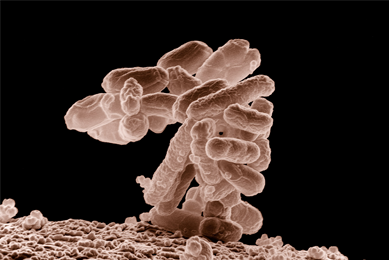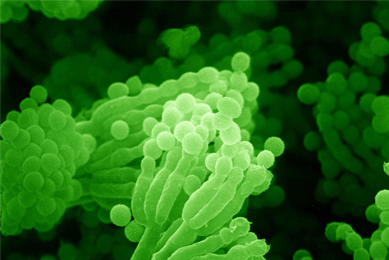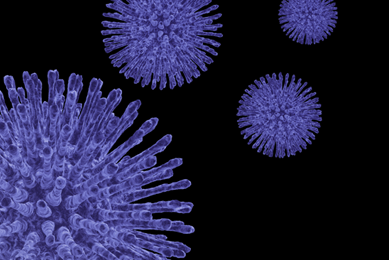From rare microbial strains to groundbreaking cell lines, each featured item will tell a unique story of scientific discovery and innovation. This campaign is not just a celebration of our rich history but also an invitation to the scientific community to contribute to and benefit from our unparalleled repository.
In this month’s post, each item below has been chosen because it holds significance to our staff—either for its influence, unique qualities, or because of its compelling story. Join us as we begin to reflect on a century of achievements and look forward to the future.
Item 1/100: A toxin-producing foodborne pathogen
Meghan Sikes, MS, Senior Biologist
ATCC® 14579™ – Bacillus cereus Frankland and Frankland
Bacillus cereus is a spore-forming and toxin-producing foodborne pathogen capable of causing both emetic and diarrheal syndromes. It is estimated to cause upwards of 12% of foodborne outbreaks globally and is naturally found in the environment.1 Due to its ubiquitous nature and spore-forming capability, this unique bacterium is a frequent contaminant of many commercially produced food products such as dairy products and canned goods. B. cereus was originally described in 1887 by Frankland and Frankland, where a sampling of air from a cow barn yielded a colony on a gelatine dish with visible spores and bacilli under a microscope.2 Today, B. cereus and its diarrheal toxins cytotoxin K (CytK), hemolysin BL (Hbl), and nonhemolytic enterotoxin (Nhe) are well known as causative agents of foodborne illness. Complete genome sequencing of type strain B. cereus ATCC® 14579™ shows that this bacterium has genes encoding all three of the enterotoxins that cause common foodborne illness symptoms.3 Despite this organism being studied for over 130 years, many avenues of future research for B. cereus and its toxins remain. There is still knowledge to uncover regarding toxin receptor structures and other virulence factors contributing to the pathogenicity of this microbe.4 This bacterium is also critical to study for public health as climate change is expected to increase the prevalence of foodborne pathogen outbreaks in the years to come.5
Item 2/100: A probiotic Lactobacillus acidophilus strain
Scott Nguyen, PhD, Senior Biocuration Scientist
ATCC® 9224™ – Lactobacillus acidophilus (Moro) Hansen and Mocquot
Lactobacillus acidophilus ATCC® 9224™ has long been studied since the 1950s for its potential probiotic properties.6,7 Isolated from sour milk, L. acidophilus ATCC® 9224™ was deposited by Morrison Rogosa (USDA) in 1946 and is known under several different strain names.8,9 Research by Thein et al. showed that oral L. acidophilus, specifically ATCC® 9224™, inhibited Candida albicans biofilm cell formation by 36%.10 This strain also shows promise as a potential probiotic as it is resistant to tea phenolic extracts.11 Recent studies are exploring its application in commercial yogurts and its use as a novel therapeutic for treating gastrointestinal cancer in a mouse model.12-14 The complete genome of ATCC® 9224™ was reported in 202415 and the genomic data should provide important commercial context for this strain’s viability as a probiotic.
Item 3/100: A potato pathogen
Chuck Na, MS, Innovation Manager
ATCC® 10182™ – Rhizoctonia solani Kühn
At the 4th Biennial meeting of the American Society of Sugar Beet Technologists in February 1946, John E. Kotila gave a talk addressing how black root disease was seriously impacting crop production.16 Dr. Kotila, a Senior Pathologist in the United States Department of Agriculture, had previously worked on identifying the cause of potato black scurf and root rot. Their investigations in the sugar beet black root led them to the same culprit: a fungal strain called Rhizoctonia solani. First described by German plant pathologist Julius Kühn in 1858,17 R. solani was isolated by Dr. Kotila and colleagues and deposited at ATCC in 1926. The strain continues to impact research and development of antifungal treatments for agriculture and remains a significant pathogen of important crops such as rice, a primary food staple for approximately 67% of the world’s population.18
Item 4/100: Cannibalism study leads to breakthrough brain disease research
Ana Eckert, BS, Senior Innovation Specialist
ATCC® VR-675™ – Kuru prion
Known for being spread through ritualistic endocannibalism (eating of relatives as part of a mourning ritual), the kuru prion causes a rare neurodegenerative disorder. This deadly disease mainly affected women and children in New Guinea in the late 18th and early 19th century.19 Dr. Gajdusek and colleagues researched the disease and discovered that it was caused by an infectious agent, even though it was not connected with fever or other inflammation. Dr. Gajdusek deposited the prion with ATCC in 1966 and was awarded The Nobel Prize in Physiology or Medicine 1976 for his breakthrough research. This work contributed to our understanding of related illnesses such as Creutzfeldt-Jakob disease, once thought to be hereditary.20 Though the practice of endocannibalism widely ended in the 1960s, the final kuru victim did not die until the 2000s due to the decades-long incubation period.21 The disease is now virtually extinct.19
Item 5/100: A lesser-known Yellowstone National Park extremophile
Rebecca Bradford, MBA, MS, PMP, Vice President of Government Programs, ATCC Federal Solutions
ATCC® 43068™ – Acidothermus cellulolyticus Mohagheghi et al.
The thermal features in Yellowstone are as dangerous as they are beautiful. They are also home to microbes that thrive within these extreme-temperature pools. Thermus aquaticus (ATCC® 25104™), isolated from Yellowstone National Park in the 1960s, has been a game changer in the life sciences in the development of PCR-based tests. It’s clear that other microbes from these extreme environments in Yellowstone have equally transformative potential. Acidothermus cellulolyticus is an enzyme-producing microorganisms that can be used to hydrolyze cellulose.22 The ability to hydrolyze cellulose has many industrial applications, and what makes this organism and enzyme so special is that it is hard at work in high heat and temperatures. As we think of industrial equipment and processes, temperatures typically reach extreme levels. The evolution of these enzyme-producing microorganisms in Yellowstone makes them perfect partners for industry customers.
Item 6/100: Human Adapted Influenza
Maria Cruz, PhD, Associate Scientist
ATCC® VR-95™ – Influenza A virus (H1N1)
The first reference to the flu dates to 412 BC to one of Hippocrates’ “Epidemics” books where a highly contagious disease with flu-like symptoms is described.23 However, experts believe that influenza viruses have been infecting us long before then, since the time of farm animal domestication.24 As science progressed, researchers have spent decades characterizing the various types of influenza viruses and developing vaccines and other treatments against it. H1N1 is one of the major subtypes of influenza A responsible for seasonal influenza.25 Major outbreaks of H1N1 throughout history include the 1918 Spanish flu epidemic, the 1977 Russian flu pandemic, and the 2009 swine flu pandemic.26,27 ATCC® VR-95™, an A/PR/8/34 strain of H1N1, was isolated in 1934 from a human patient in Puerto Rico and was deposited in the ATCC collection in 1934 by W.A. Chappell and M. Coleman from the Centers for Disease Control and Prevention. This strain is still in use today as a donor virus for vaccine production. Since the deposit of this strain, ATCC has developed a tissue-adapted version (ATCC® VR-1469™) and a high-titer version (ATCC® VR-95PQ™) of the strain and has developed quantitative genomic RNA standards (ATCC® VR-95DQ™, ATCC® VR-1469DQ™) as well. As part of ATCC’s commitment to quality, whole-genome reference sequences for these products are also available through our ATCC Genome Portal.
Items 7/100 and 8/100: INPs – Froze and Cons
Sydney McKnight, MS, Biologist, and James Budnick, PhD, Senior Scientist
ATCC® 39254™ – Pseudomonas syringae and ATCC® 27155™ – Pantoea agglomerans
Pseudomonas syringae and Pantoea agglomerans (formerly Erwinia herbicola) are gram-negative bacteria that have been commonly used as model organisms for understanding mechanisms in plant pathogen interactions.28-30 In the early 1980s, researchers investigating frost injury to plants made a notable discovery: plants inoculated with these microbes experienced frost damage at temperatures significantly higher than those lacking these microbes.31 This frost-induced damage not only compromises the plants’ overall health but also makes vital nutrients available to microbial pathogens.32 It was later identified that a group of ice nucleation proteins (INPs) produced by these bacteria are responsible for facilitating ice formation at these elevated temperatures. Further research revealed that other ice-nucleating active (INA) particles, including various microbes and particles, also contribute to this phenomenon.33,34
The discovery of these proteins has allowed scientists to transform these plant pathogens into unlikely heroes. Snomax International, a North American company that started in 1987, utilize these proteins in their product Snomax®, which is used by the ski industry to help facilitate snow creation. They claim that by adding their product (a purified version of INPs), they can increase snow production by 90% while only increasing water usage by 3.5%.35 Furthermore, scientists are also studying the potential role of INPs in improving the freezing and storing processes for foods.36
Did you know?
ATCC’s oldest collection items are older than the company itself. In 1922—three years before ATCC was established—Lore Rogers transported the founding collection of 175 microorganisms from the American Museum of Natural History in New York to the Army Medical Museum in Washington, D.C.
Learn more about our microorganisms

Bacteriology and Archaea
ATCC offers a variety of bacterial and archaeal strains with applications in a variety of research and industrial applications. Our growing portfolio includes antimicrobial-resistant strains, quality control organisms for commercial identification systems, a wide selection of extremophile strains, and genomic and synthetic DNA.
MoreReferences
- Dietrich R, et al. The Food Poisoning Toxins of Bacillus cereus. Toxins (Basel) 13(2): 98, 2021. PubMed: 33525722.
- Frankland GC, Frankland PF. Studies on some new micro-organisms from air. Philos Trans R Soc Lond B Biol Sci 173: 257-287, 1887.
- Ivanova N, et al. Genome sequence of Bacillus cereus and comparative analysis with Bacillus anthracis. Nature 423, 87–91, 2003. PubMed: 12721630
- Tirloni E, et al. Bacillus cereus in Dairy Products and Production Plants. Foods 11(17): 2572, 2022. PubMed: 36076758.
- Foxcroft N, Masaka E, Oosthuizen J. Prevalence Trends of Foodborne Pathogens Bacillus cereus, Non-STEC Escherichia coli and Staphylococcus aureus in Ready-to-Eat Foods Sourced from Restaurants, Cafés, Catering and Takeaway Food Premises. Int J Environ Res Public Health 21(11): 1426, 2024. PubMed: 39595693.
- Soulides DA. A Synergism Between Yoghurt Bacteria and Yeasts and the Effect of Their Association Upon the Viability of the Bacteria. Appl Microbiol 3(3): 129–131, 1955. PubMed: 14377375.
- Soulides DA. Lactose-fermenting Yeasts in Yoghurt and Their Effect upon the Product and the Bacterial Flora. Appl Microbiol 4(5): 274–276, 1956. PubMed: 13363391.
- Bull M, et al. The life history of Lactobacillus acidophilus as a probiotic: a tale of revisionary taxonomy, misidentification and commercial success. FEMS Microbiol Lett 349(2): 77–87, 2013. PubMed: 24152174.
- Sarra PG, et al. Genetic heterogeneity among Lactobacillus acidophilus strains. Antonie Van Leeuwenhoek 46(2): 169–176, 1980. PubMed: 6776893.
- Thein ZM, Samaranayake YH, Samaranayake LP. Effect of oral bacteria on growth and survival of Candida albicans biofilms. Arch Oral Biol 51(8): 672–680, 2006. PubMed: 16620775.
- Hervert-Hernández D, Goñi I. Dietary Polyphenols and Human Gut Microbiota: a Review. Food Reviews International 27(2): 154–169, 2011.
- Basyigit Kilic G, Akpinar Kankaya D. Assessment of technological characteristics of non-fat yoghurt manufactured with prebiotics and probiotic strains. J Food Sci Technol 53(1): 864–871. PubMed: 26788009.
- Kılıç GB, Akpınar D. The effects of different levels of β-glucan on yoghurt manufactured with Lactobacillus plantarum strains as adjunct culture. J Food Agric Environ 11(1): 281-287, 2013.
- Fu T, et al. Paired microbiome and metabolome analyses associate bile acid changes with colorectal cancer progression. Cell Rep 42(8): 112997, 2023. PubMed: 37611587.
- Kumar A, et al. The complete genome sequence of probiotic Lactobacillus acidophilus ATCC 9224 isolated from sour milk. Microbiol Resour Announce 13(4): e0067723, 2024. PubMed: 38488370.
- Coons GH, et al. “1946 4th Biennial Meeting of the American Society of Sugar Beet Technologists.” Black Root of Sugar Beets and Possibilities for Its Control , pp. 364–380. DOI: 10.5274/ASSBT.1946.364
- Parmeter JR, editor. Rhizoctonia Solani: Biology and Pathology. DGO-Digital original, 1, University of California Press, 1970. JSTOR, http://www.jstor.org/stable/jj.8500917. Accessed 11 Dec. 2024.
- Senapati M, et al. “Rhizoctonia solani Kühn Pathophysiology: Status and Prospects of Sheath Blight Disease Management in Rice.” Frontiers in plant science vol. 13 881116. 3 May. 2022, doi:10.3389/fpls.2022.881116
- Liberski PP, Brown P. Kuru: its ramifications after fifty years. Exp Gerontol 44 (1-2): 63-69, 2009.PubMed: 18606515.
- The Nobel Prize. D. Carleton Gajdusek – Facts. NobelPrize.org. Nobel Prize Outreach AB 2024. Tue. 5 Nov 2024. <https://www.nobelprize.org/prizes/medicine/1976/gajdusek/facts/>
- Collinge J, et al. Kuru in the 21st century—an acquired human prion disease with very long incubation periods. Lancet 367(9528): 2068-2074, 2006. PubMed: 16798390.
- Mohagheghi A, et al. Isolation and characterization of Acidothermus cellulolyticus gen. nov., sp. nov., a new genus of thermophilic, acidophilic, cellulolytic bacteria. Int J Syst Bacteriol 36: 435-443, 1986.
- Ghendon Y. Introduction to pandemic influenza through history. Eur J Epidemiol 10(4): 451-453, 1994. PubMed: 7843353.
- Flu. The history of influenza. Published 2022. Retrieved December 2024 from https://www.flu.com/Articles/2022/The-History-of-Influenza.
- Centers for Disease Control and Prevention. (n.d.). Types of influenza viruses. Retrieved December 12, 2024, from https://www.cdc.gov/flu/about/viruses-types.html.
- Mermel LA. Swine-origin influenza virus in young age groups. Lancet 373(9681): 2108-2109, 2009. PubMed: 19541030.
- Mayo Clinic. (n.d.). History of disease outbreaks and vaccine timeline: Influenza. Retrieved December 12, 2024, from https://www.mayoclinic.org/diseases-conditions/history-disease-outbreaks-vaccine-timeline/flu.
- Xin X-F, Kvitko B, He SY. Pseudomonas syringae: what it takes to be a pathogen. Nat Rev Microbiol 16(5): 316–328, 2018. PubMed: 29479077.
- Arnold DL, Preston GM. Pseudomonas syringae: enterprising epiphyte and stealthy parasite. Microbiology (Reading) 165(3): 251–253, 2019. PubMed: 30427303.
- Rezzonico F, et al. Genotypic comparison of Pantoea agglomerans plant and clinical strains. BMC Microbiol 9: 204, 2009. PubMed: 19772624.
- Lindow SE, Arny DC, Upper CD. Bacterial ice nucleation: a factor in frost injury to plants. Plant Physiol 70(4): 1084–1089, 1982. PubMed: 16662618.
- Roeters SJ, et al. Ice-nucleating proteins are activated by low temperatures to control the structure of interfacial water.Nat Commun 12(1): 1183, 2021. PubMed: 33608518.
- Hollomon L. The Bacterial Secret to Snow: How P. syringae Shapes Winter and Revolutionized Ski Resorts. Medium. Published October 1, 2024. Accessed online December 2024 from https://medium.com/science-wonder/the-bacterial-secret-to-snow-how-p-syringae-shapes-winter-and-revolutionized-ski-resorts-6c832408f959#:~:text=Instead%2C%20billions%20of%20microscopic%20proteins,fun%20on%20the%20ski%20slopes.
- Huang S, et al. Overview of biological ice nucleating particles in the atmosphere. Environ Int 146: 106197, 2021. PubMed: 33271442.
- Snomax.com website. Accessed December 2024 from https://www.snomax.com/product/the-study.html. SNOWMAX is a registered trademark of TECHNOALPIN HOLDING S.P.A.
- Tian Y, Zhu Z, Sun D-W. Naturally sourced biosubstances for regulating freezing points in food researches: Fundamentals, current applications and future trends. Trends in Food Science & Technology 95: 131–140, 2020.

